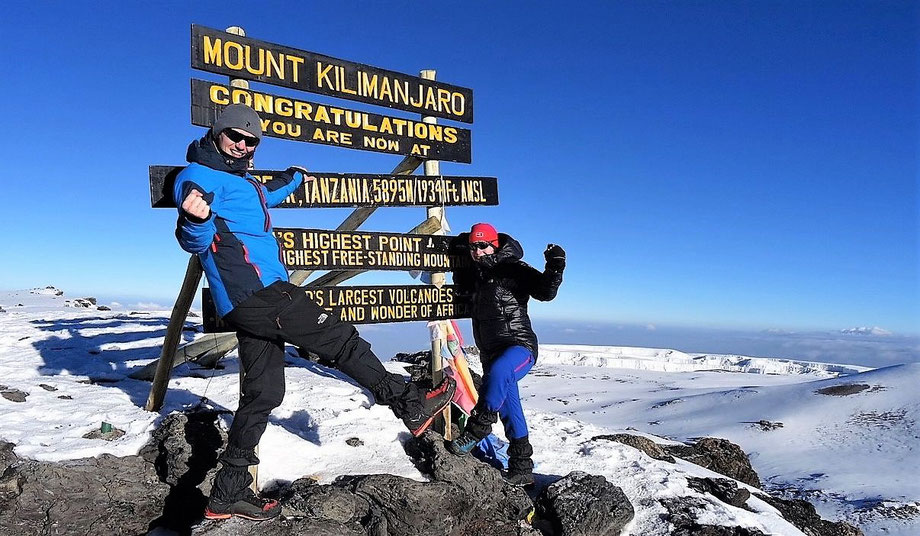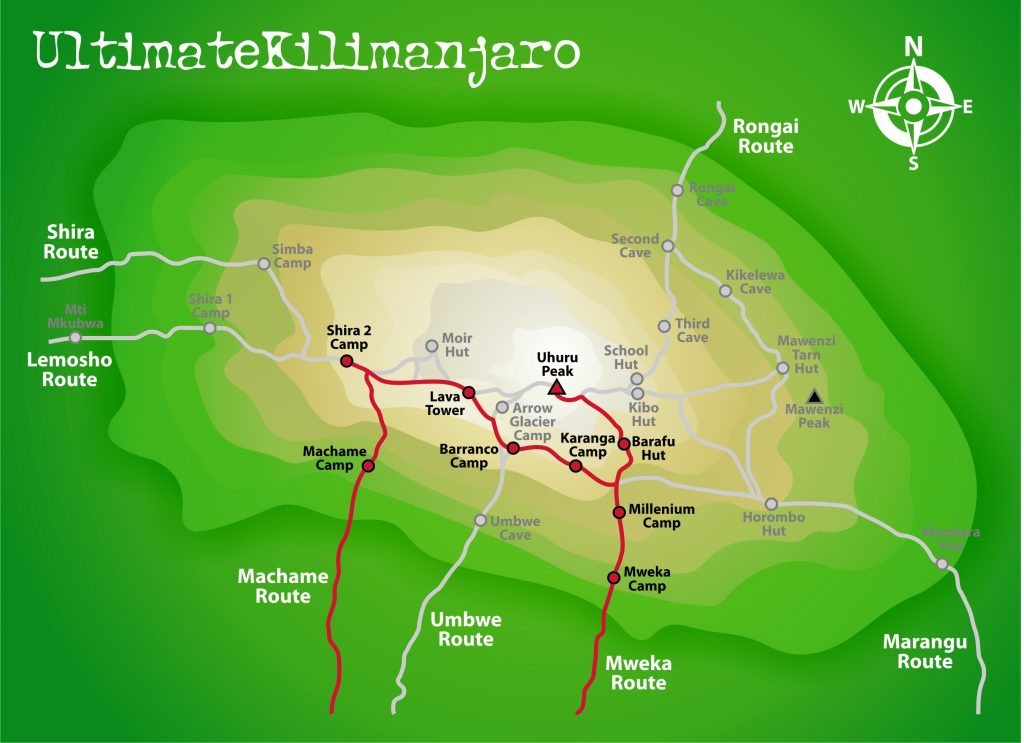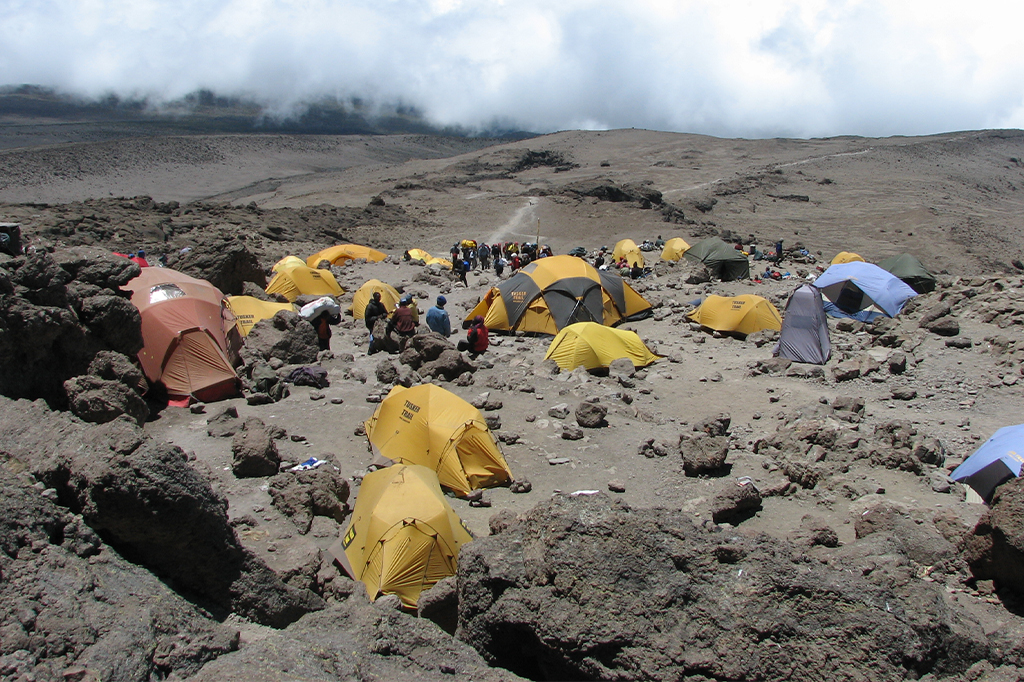Machame Route: 100% Best Rout For Climbing Mt Kilimanjaro
Machame Route, With over 15 years of experience, we have assisted more over 12,000 individuals in reaching the peak of Kilimanjaro. Utilizing superior equipment and the most skilled guides on the mountain, we maintain a 95% success rate across all routes we operate. Since 2009, we have been proud supporters of KPAP, ensuring that the wellbeing of our local personnel remains a priority. As with all our expeditions, your journey to Kilimanjaro with Kandoo is inherently carbon offset by default.
The Machame route commences at Machame Gate, situated at an elevation of 1800 meters, approaching from the southwest of the mountain. On the first day, it traverses a magnificent rainforest before ascending the mountain to arrive at Shira Camp, where the Lemosho path converges from the west. From this point, you navigate the southern slope of the mountain to Barranco via Lava Tower, ascending the Great Barranco Wall on route to Barafu Camp. Upon reaching the summit, you will descend via the Mweka trail instead of retracing your ascent route
The Machame route, referred to as the ‘Whiskey route,’ is deemed more challenging than the ‘Coca Cola way,’ which designates the Marangu way. In actuality, it is not more technically challenging, but is lengthier and in certain areas, more precipitous. The extended distance and the chance to ‘ascend gradually, descend for rest’ facilitate superior acclimatization, resulting in a significantly elevated success rate.
The Machame route is an excellent seven-day trip for individuals with limited experience at high altitudes, incorporating an additional day for acclimatization, which enhances the success rate. Seasoned and acclimatized mountaineers may choose the more challenging six-day ascent via the Machame route.

Machame Route Detailed itinerary
All hikers must arrange their own flights to Kilimanjaro International Airport (JRO). A private transfer to your hotel will be arranged from JRO. On that night or the following morning, you will convene with your local All Tanzania Safaris agent for a comprehensive pre-climb briefing.
Conveyance from your accommodation to Machame Gate for registration. Our porters organize and load our provisions and luggage prior to commencing our trek up the forest trail to Machame Camp at 3000 meters. We shall remain here for the night.
- Transport: Private transfer
- Hiking time: 6 – 7 hours
- Ascent: 1200 m
- Max. altitude: 3000 m
- Accomodation: Camping
- Meals included: Breakfast / Lunch / Dinner
Following breakfast, we commence our trek, departing from the rainforest, and proceed with our rise, traversing a minor valley and ascending a high, rocky ridge adorned with heather. We will now proceed westward into a river gorge until we arrive at Shira Cave Camp. Tonight will be colder than last night, with temperatures potentially dropping below freezing.
- Hiking time: 5 – 6 hours
- Ascent: 850 m
- Max. altitude: 3850 m
- Accomodation: Camping
- Meals included: Breakfast / Lunch / Dinner
Today, we will ascend to 4600 meters to the base of the Lava Tower for lunch and acclimatization. This will be our most challenging day to date, and you may, for the first time, experience the effects of altitude. Post-lunch, we will descend over 650 meters to Barranco Camp, adhering to the principle of ‘walk high, sleep low’ for acclimatization. The descent to Barranco Camp lasts approximately 2 hours and provides excellent opportunity for capturing stunning images of the Western Breach and Breach Wall. The camp is located in a valley beneath the Breach and Great Barranco Wall.
A brief yet enjoyable day commencing with a struggle to the summit of the Great Barranco Wall. We thereafter navigate across scree to the Karanga Valley (3930m), situated beneath the icefalls of the Heim, Kersten, and Decken Glaciers. We will spend the night in Karanga campground.
- Hiking time: 4 hours
- Ascent: 260 m
- Descent: 280 m
- Max. altitude: 4210 m
- Accomodation: Camping
- Meals included: Breakfast / Lunch / Dinner
We depart from the Karanga campsite to reach the intersection that connects with the Mweka descending trail. We proceed to Barafu Camp from this point. Here, we can repose, savor dinner, and ready ourselves for the peak day. The camp provides stunning vistas of the summit and the dual peaks of Mawenzi and Kibo.
- Hiking time: 4 – 5 hours
- Ascent: 465 m
- Max. altitude: 4675 m
- Accomodation: Camping
- Meals included: Breakfast / Lunch / Dinner
Day 7 Barafu Camp to Summit to Mweka Camp You will be awakened around 23:30 with tea and biscuits. We commence our ascent to the summit, traversing between the Rebman and Ratzel glaciers through challenging scree to Stella Point on the crater rim. This segment of the trek is the most mentally and physically demanding. At Stella Point (5732m), we will pause briefly, ideally in time to witness the breathtaking sunrise (weather permitting). We are now merely an hour from the summit, Uhuru Peak (5895m), the highest elevation on Mount Kilimanjaro and in Africa. From the summit, we will descend to Mweka Camp, stopping at Barafu Camp for lunch. Trekking poles will be essential for navigating the loose scree en route to Mweka Camp (3100m). Later in the evening, we will savor our final dinner on the mountain and enjoy a well-deserved rest.
- Hiking time: 14 – 16 hours
- Ascent: 1220 m
- Descent: 2795 m
- Max. altitude: 5895 m
- Accomodation: Camping
- Meals included: Breakfast / Lunch / Dinner
On your final day of the hike, after breakfast, we will descend an additional 1300 meters to the Mweka Park Gate to collect your summit certificates from the Park Headquarters. Conveyance to your hotel.
- Transport: Private transfer
- Hiking time: 3 – 4 hours
- Descent: 1300 m
- Max. altitude: 3100 m
- Accomodation: Hotel
- Meals included: Breakfast
Following a much-needed night’s rest, we shall bid you farewell. If you have scheduled airport transfers with us or a safari/Zanzibar excursion, we will retrieve you in the morning for your further journey.

How Difficult to climb Mt Kilimanjaro through Machame Route
The Machame route is regarded as relatively challenging. Based on your fitness level, you will be walking for 6-7 hours almost daily, at progressively higher altitudes. For the summit ascent, you must be prepared to be on your feet for an extensive duration of 12 to 15 hours. Ascending for 6-8 hours and down for 6-7 hours. Arriving in excellent physical condition and possessing a resilient mental “All Tanzania Safaris ” mindset will be essential for your success!
Inexperienced climbers may feel apprehensive about navigating the Great Barranco Wall; nevertheless, it is really a brief scramble that is not particularly challenging, and your guide will assist you throughout the process. The most perilous aspect you will encounter is a single stride around a rock outcrop. Numerous climbers traverse this path annually, in addition to the Kilimanjaro porters transporting substantial burdens. Seeking training guidance or a regimen in anticipation of this journey? We recommend exploring Kate Sielmann and her coaching packages tailored for mountaineering and trekking training. Obtain additional information here.
Food to carry during Hiking mt Kilimanjaro through Machame Route
Maintaining proper nutrition during your ascent is essential, particularly when circumstances may diminish your appetite for food and hydration. Due to the prevalent loss of appetite among climbers at high altitudes, our head chef has created specialized menu plans that are enticing, nutritious, and rich in the energy required to reach the summit. Our meals inherently comprise fresh fruit and vegetables daily. Fresh meat will be available throughout the initial segment of the journey, and on the southern routes where practicable, we will replenish the party at Karanga Camp. Upon your return to Base Camp following your summit trek, a unique reward awaits: a “All Day English Breakfast.” Please inform our cook of your preferred egg preparation. Prior to departing the mountain, you will have the opportunity to taste several local Tanzanian dishes, like Njegere and Machalari.
Accommodation

Your comprehensive day-by-day itinerary outlines the inclusions for hotel accommodations and lunch provisions. All pre- and post-climb accommodations are located in Moshi. Should you go on a safari before your ascent, we will have arranged accommodations for you in Arusha upon your arrival to minimize your travel duration. If your hotel operates on a B&B basis, you can typically acquire snacks or meals on-site, payable in Tanzanian Shillings or frequently in US Dollars. Upon arrival at the hotel, take a time to acquaint yourself with the layout and the protocols for fire emergencies, particularly the escape routes and fire exits.
Kindly note that Tanzania remains a developing nation, and interruptions in water and energy supply occur frequently; thus, we cannot assure the availability of hot showers at the hotel throughout your stay. The hotel will assist to the extent possible; but, these interruptions are beyond their control.
We utilize just the finest high-altitude mountain tents, the Mountain Hardwear Trango 3, to guarantee your warmth, dryness, and comfort during your Kilimanjaro ascent. Kindly note that they are specialized mountain tents, engineered to withstand extreme conditions; therefore, do not anticipate the ability to stand and move around within. The arid, dusty conditions on Kilimanjaro might disrupt the zippers, causing them to jam quickly. Our guides own WD-40; please request them aid instead of attempting to push the zipper.
Your meals will be served in a designated mess tent, allowing you to sit comfortably, converse with your teammates, and savor the nutritious food freshly made by our cook. Within, you will discover a table and a suitably comfortable armchair. With a complete 2 meters of headroom, even the highest climbers may extend and maneuver without stooping. They are entirely waterproof and consistently endure the most severe weather conditions that Kilimanjaro presents. A toilet tent is equipped with toilet paper.
Transport
We mandate the utilization of superior vehicles and drivers for all our transports. In Tanzania, it is not legally mandated to equip vehicles with rear seatbelts, and although we endeavor to utilize vehicles that are supplied with them, this cannot always be assured. If you are dissatisfied with any part of the car or the quality of driving, please contact the driver or our local office without delay. It is a frequent occurrence in Tanzania for police to halt automobiles to inspect the driver’s documents, which may be extremely terrifying if one does not comprehend the spoken language. If your vehicle is halted, it does not indicate any deficiency in the condition of the vehicle or the driver’s capabilities.
Luggage
WEIGHT OF CLIMBING BAG
Kilimanjaro National Park enforces a stringent limit of 15kg per porter for your primary equipment pack. This restriction encompasses your sleeping bag, regardless of whether it is rented from us. This is more than adequate for your requirements on the mountain. Your bag will be weighed before to your departure from the hotel for the ascent, and if it exceeds the weight limit, you must remove goods and leave them at the hotel. Extra porters may be employed at a cost of $25 per day.
PROHIBITION OF PLASTIC BAGS
Tanzania implemented a prohibition on all single-use plastic bags on June 1, 2019. Kindly assist in the battle against plastic by utilizing more sustainable alternatives in your luggage, such as packing cubes and dry bags. Travelers possessing plastic bags in their baggage may be required to relinquish them upon arrival at the airport.
Zip-lock bags for transporting liquids and toiletries in cabin baggage on airlines will continue to be allowed.
How To get to mt Kilimanjaro (Machame Route )
Climbers residing in the UK or the US should ideally fly to Kilimanjaro International Airport (JRO). KLM has flights to JRO from all principal UK airports and numerous major US international airports. Flights from the UK often depart in the early morning, transfer at Amsterdam’s primary airport, Luchthaven Schiphol, and arrive in JRO late that evening.
All of our journeys commence in Moshi, recognized as the entrance to Mount Kilimanjaro. Moshi is located at a low elevation on the southern slope of the mountain, around 1000 meters above sea level. Moshi is situated about 25 miles from Kilimanjaro International Airport by automobile, and we will facilitate transportation from the airport to your hotel as an integral component of your expedition. Transportation is typically accessible at all hours, including late evening and early morning, and has an approximate duration of forty-five minutes.
Moshi is an exceptional option for hotel accommodation during your visit; but, it tends to reach full capacity rapidly during peak season, so ensure you get your reservation with us as early as possible. It is prudent to schedule a rest day following an extensive flight to recuperate and ready yourself and your equipment for the ascent, rather than intending to tackle the mountain the subsequent morning.
Certain UK climbers opt to fly to Nairobi with Kenyan Airways or British Airways. These flights are exclusively available for departure from Heathrow in London. Climbers arriving in Nairobi typically reserve a connecting flight to Kilimanjaro International Airport with Precision Air, Air Kenya, Air Tanzania, or Ethiopian Airways.
We advise against transiting through Nairobi, as Nairobi Airport frequently presents discomfort, and transfer durations can occasionally be excessively prolonged. It is also known for inadequate luggage handling and delays in the transfer of bags between planes.
Turkish Airlines, Emirates, and Qatar Airways currently operate flights to JRO; nevertheless, these services frequently entail significant delays and departures late at night for UK travelers. Climbers from the US frequently report superior service and experiences while flying with Turkish Airlines, Emirates, and Qatar; therefore, we recommend these airlines for flights from North America.
Vayama provides exceptional flights to East Africa, encompassing Tanzania, Uganda, Kenya, and Zanzibar from JRO, making it a fantastic option for anyone seeking to see this stunning region prior to returning home. Numerous travelers arrange a beach vacation in the exotic locale of Zanzibar to recuperate following their ascent. The optimal arrangement for transportation is to schedule your return trip from Dar Es Salaam, followed by an internal flight to Zanzibar, and subsequently return to Dar Es Salaam for your homeward journey.
When switching airlines or re-checking luggage at an airport during transit, please allocate a minimum of 3 hours between flights. This will consider any delays in arrival, travel duration between airports (which may exceed expectations), and the time required for re-checking baggage.
Budget
The Tanzanian Shilling is a restricted currency, hence it cannot be purchased prior to your arrival. Traveling using US Dollars is recommended, as they are broadly accepted. It is crucial that US currency be recent (not exceeding 10 years), pristine, and unblemished. If you require local currency to buy snacks or beverages at your accommodation or en route to the climb, we can escort you to an ATM or bank. A currency exchange is available as you proceed to the Baggage Collection area of the airport. When depending on a credit or debit card for emergency money, ensure you inform your card issuer of your intention to use it internationally; otherwise, it may become inoperative when you require it most.
Be advised that not all hotels accept card payments; therefore, you may need to utilize an ATM to obtain dollars.
Tips
We collaborate closely with the Kilimanjaro Porters Assistance Project, which has advised the following tipping protocol. KPAP recommends a daily gratuity range of $6-10 per porter. We suggest a remuneration of $20 per day for guides, and $12 to $15 per day for both assistant guides and cooks. These data pertain to each group, rather than individual climbers. A copy of the tip recommendations and the projected staff numbers for your group will be given to you. The crew size may only be verified on the initial day of the ascent once all bags and equipment have been weighed at the park entrance. At the initial camp, you will be informed of the definitive number of crew members and their respective roles in the ascent.
During your summit attempt, you may observe that certain porters accompany the group to offer supplementary support. This is an ancillary activity they perform to enhance your likelihood of attaining the top. Kindly express your gratitude for any assistance received by directly tipping the porters. We recommend an additional gratuity of $20.
The tipping announcement will occur on the final evening on the mountain when the entire team convenes to celebrate with you. A representative from your group should express gratitude, which will be translated into kiSwahili by the main guide.
In light of recent thefts on Kilimanjaro, we no longer recommend that our clients carry cash during the ascent; therefore, the genuine gratuity will be provided upon your return to the accommodation. Your group will get envelopes to facilitate the distribution of gratuities—one envelope designated for the porters and another for tipping your lead guide, assistant guides, and cook. Three representatives of the porters will arrive at the hotel to receive the tip envelope on behalf of all porters and will personally allocate the funds.
